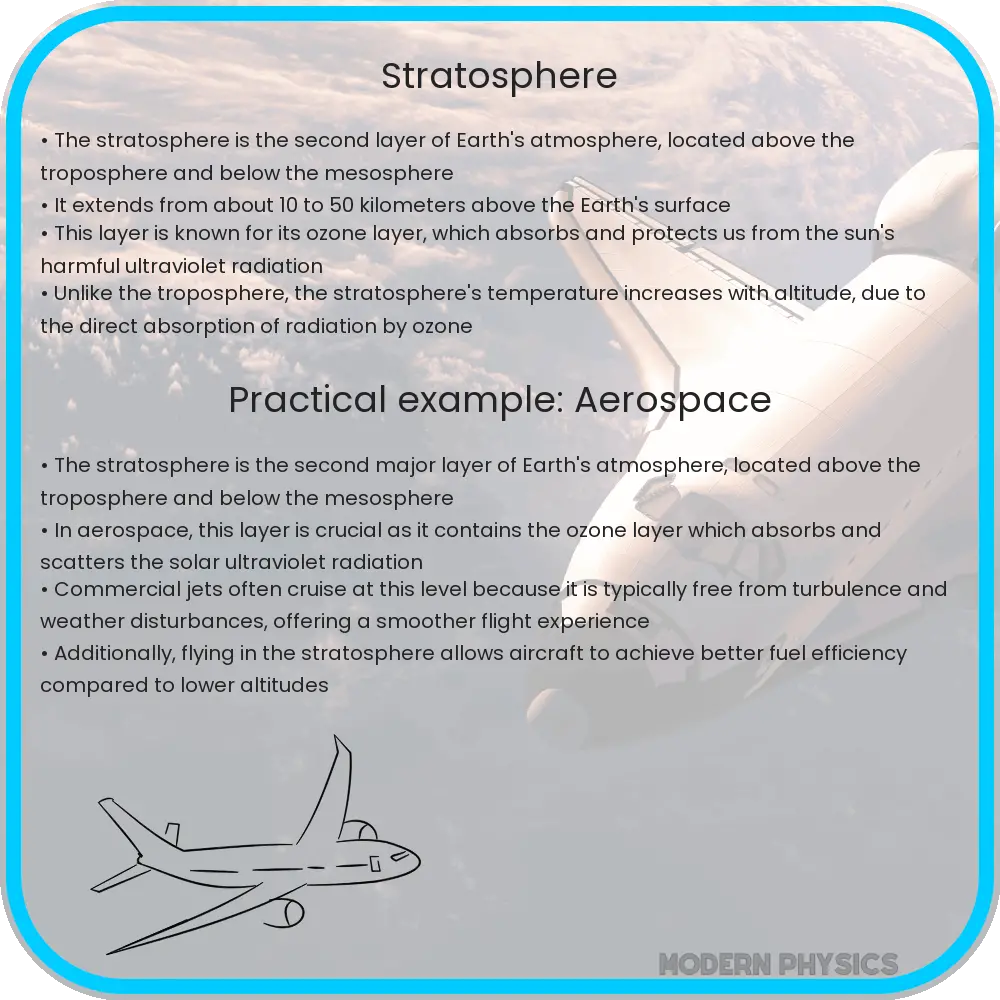Explore the stratosphere’s role, composition, dynamics, and impacts on climate and weather patterns.

Understanding the Stratosphere: Composition and Dynamics
The stratosphere is a key layer of Earth’s atmosphere, situated above the troposphere and below the mesosphere. Extending from about 10 kilometers (6 miles) to 50 kilometers (31 miles) above Earth’s surface, this layer plays a critical role in atmospheric chemistry, dynamics, and its influence on climate patterns.
Composition of the Stratosphere
The stratosphere is primarily composed of dry air, with significantly lower moisture levels compared to the troposphere below it. The major components of this dry air are nitrogen (approximately 78%) and oxygen (around 21%), with trace amounts of other gases such as argon, carbon dioxide, and neon. One of the most notable aspects of the stratosphere is its ozone concentration, particularly in the ozone layer, which is located about 15 to 35 kilometers above Earth’s surface. This layer absorbs and scatters the solar ultraviolet radiation, protecting life on Earth from harmful UV rays.
Dynamics of the Stratosphere
Unlike the weather-active troposphere below, the stratosphere has a stratified structure with relatively stable conditions. Temperature within the stratosphere increases with altitude, a reversal from the pattern observed in the troposphere. This temperature increase is primarily due to the absorption of ultraviolet radiation by the ozone layer, which heats the air around it. This warming creates a stable atmospheric layer where air mixing is significantly reduced compared to lower layers.
The dynamics of the stratosphere are also marked by large-scale wave patterns and the quasi-biennial oscillation (QBO). The QBO is a regular variation in the direction of wind flow around the equator, switching between easterly and westerly winds approximately every 28 months. This oscillation affects not only the weather patterns in the stratosphere but also has implications for weather in the troposphere.
- Polar Vortices: During the winter months in each hemisphere, strong and persistent wind patterns known as polar vortices develop around the poles. These vortices play a significant role in the winter weather patterns and the distribution of ozone.
- Stratospheric Warming: Occasionally, rapid warming events can occur in the stratosphere, known as sudden stratospheric warmings. These events can lead to dramatic shifts in the winter weather patterns of the northern hemisphere.
Understanding the dynamics of the stratosphere is crucial for meteorologists and climate scientists as it helps in predicting weather and studying climate change impacts. The interactions between the stratosphere and the troposphere, especially through stratospheric intrusion events, can influence severe weather occurrences such as thunderstorms and tornadoes.
Impact of the Stratosphere on Climate and Weather
The stratosphere’s influence on terrestrial climate and weather patterns is substantial, albeit often indirectly perceived. The significant role of the ozone layer in modulating the Earth’s temperature balance highlights one of its key functions. By absorbing a majority of the sun’s harmful ultraviolet radiation, the ozone layer not only protects biological life but also stabilizes the thermal structure of the atmosphere.
This stabilization allows for the formation of jet streams—fast flowing, narrow air currents that travel around the planet. These jet streams play a critical role in the development and progression of weather systems across the globe. Variations in the stratosphere, such as those caused by the QBO or sudden stratospheric warmings, can alter jet stream patterns, subsequently affecting weather conditions in the troposphere, leading to phenomena such as prolonged cold spells or unseasonably warm weather in temperate regions.
Environmental and Human Impacts
The health of the stratosphere is directly linked to environmental and human health. Ozone depletion, primarily caused by human-made chemicals like chlorofluorocarbons (CFCs), poses significant risks. Prolonged exposure to high levels of UV radiation can lead to a variety of health issues in humans and wildlife, including skin cancers, cataracts, and reduced immune function.
Efforts such as the Montreal Protocol, an international treaty signed in 1987 to phase out the production of numerous substances responsible for ozone depletion, have shown significant positive impacts in reducing the amount of harmful substances in the atmosphere. This agreement demonstrates the potential for global cooperation in addressing atmospheric issues that have far-reaching effects on both the environment and human health.
Conclusion
The stratosphere, while distant from the daily experiences of most living on Earth, plays a fundamental role in maintaining the planet’s climate and weather patterns. Its overall health and stability affect everything from the global distribution of temperatures to the protection against ultraviolet radiation. Understanding and protecting this critical layer of our atmosphere is essential not only for the perpetuation of human life but for the planet as a whole. By monitoring changes within the stratosphere and taking actions to mitigate negative impacts like ozone depletion, humans can help ensure a stable and hospitable climate for future generations.
